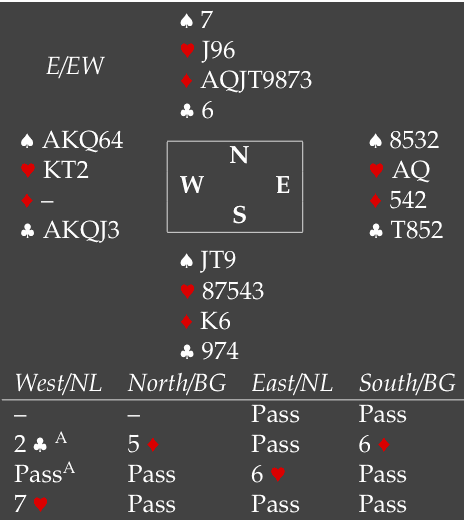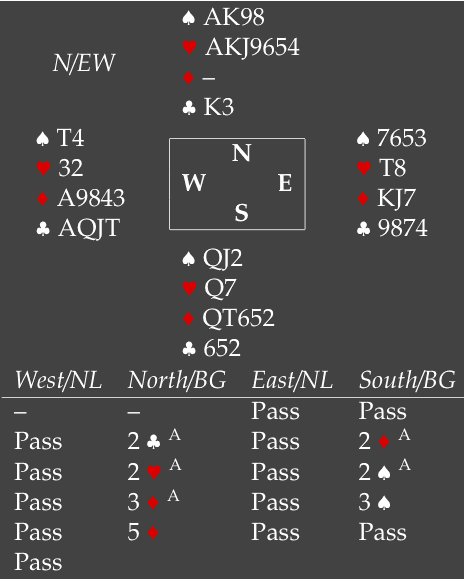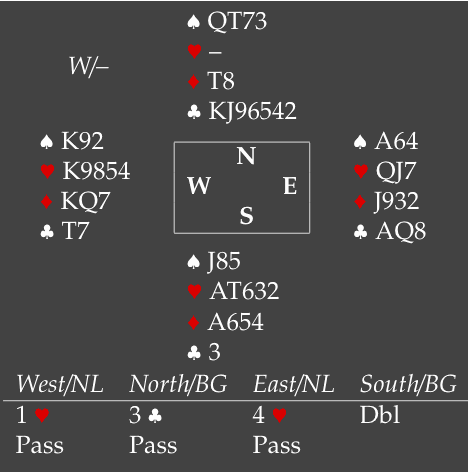 Most players are familiar with the “law of total tricks” (LOTT) discovered by Jean-Rene Vernes in the 1960’s. For those of you who aren’t, the LOTT says that the number of tricks that can be taken by NS and EW in their best trump suit is, on average, equal to the number of trumps held by the 2 sides. That is, if NS have 9 spades and EW have 9 hearts, on average, a total of 18 tricks can be made in heart and spade contracts: 3♠ and 3♥ both making, 3♠ with an overtrick and 3♥ down 1, 4♠ down 2 and 4♥ making, and so on. Of course, it is a statistical law and it only says something about what happens in the long run, just as a rule as “with 25 high card points and 2 balanced hand, 3NT is a good contract” is only true on average. The LOTT is quite useful in competitive bidding and lots conventions and bidding advice is implicitly based on it.
Most players are familiar with the “law of total tricks” (LOTT) discovered by Jean-Rene Vernes in the 1960’s. For those of you who aren’t, the LOTT says that the number of tricks that can be taken by NS and EW in their best trump suit is, on average, equal to the number of trumps held by the 2 sides. That is, if NS have 9 spades and EW have 9 hearts, on average, a total of 18 tricks can be made in heart and spade contracts: 3♠ and 3♥ both making, 3♠ with an overtrick and 3♥ down 1, 4♠ down 2 and 4♥ making, and so on. Of course, it is a statistical law and it only says something about what happens in the long run, just as a rule as “with 25 high card points and 2 balanced hand, 3NT is a good contract” is only true on average. The LOTT is quite useful in competitive bidding and lots conventions and bidding advice is implicitly based on it.
Less well known but probably as useful, is a rule invented by British expert David Burn, known as “Burn’s law of total trumps”. This one simply says:
- When you are declarer, the total number of trumps held by your side should be greater than the total number of trumps held by the opponents.
Makes sense does it? A simple law to follow in practice?

 Well, this morning’s match between the Netherlands and Bulgaria at the World Junior Championships showed some disastrous results when players Burn’s law wasn’t followed. First this deal. As you can see, EW can make 13 tricks in either black suit and this is what happened at 14 of the 20 tables, while NS can make about 8 tricks in diamonds (5 tables). In all cases, the declaring side had more trumps than the opponents. At the 20th table, Burn’s law was violated.
Well, this morning’s match between the Netherlands and Bulgaria at the World Junior Championships showed some disastrous results when players Burn’s law wasn’t followed. First this deal. As you can see, EW can make 13 tricks in either black suit and this is what happened at 14 of the 20 tables, while NS can make about 8 tricks in diamonds (5 tables). In all cases, the declaring side had more trumps than the opponents. At the 20th table, Burn’s law was violated.
 West started with 2♣, containing only strong options, the preempt was a level higher, and west found himself at the 6 level at his second turn. Now, pass is obviously forcing at this turn, so that is what he picked. With the east hand, I’d now have doubled, west has asked you to suggest a contract and 6♦x looks best. No, east decided to suggest a suit. West now seems to have forgotten that he forced partner to bid something. His raise to 7♥ seems completely over the top, partner must have at least ♥AQxxx and that is a big gamble. Nobody doubled. The contract was completely unplayable. Down 6, for an 18 imp loss against 6♣ making in the other room. The deal bears some resemblance to a hand discussed here earlier. I thought these juniors had training sessions where disasters were discussed...
West started with 2♣, containing only strong options, the preempt was a level higher, and west found himself at the 6 level at his second turn. Now, pass is obviously forcing at this turn, so that is what he picked. With the east hand, I’d now have doubled, west has asked you to suggest a contract and 6♦x looks best. No, east decided to suggest a suit. West now seems to have forgotten that he forced partner to bid something. His raise to 7♥ seems completely over the top, partner must have at least ♥AQxxx and that is a big gamble. Nobody doubled. The contract was completely unplayable. Down 6, for an 18 imp loss against 6♣ making in the other room. The deal bears some resemblance to a hand discussed here earlier. I thought these juniors had training sessions where disasters were discussed...

The Bulgarians did not want to be outdone in Burn’s law violations, as this happened 2 boards later. Closed, the Dutch bid to a rather uneventful 4♥, making 6 when the club finesse was on. Slam is on a finesse and you don’t want to bid that. In the open room something went horribly wrong. 2♣ was strong, 2♥ showed hearts or a balanced hand, 2♠ asked, 3♦ showed hearts without a second suit, 3♠ intended as natural and 5♦ was intended as Exclusion Blackwood, asking for aces in the suits outside diamonds. At least by north. South had a different point of view, with his lousy hand, he had been forced to bid 3 times when partner finally bid his long suit. Guess what he did? Pass. 5♦ with only 5 trumps versus the opponent’s 8 wasn’t a success, down 4. 12 imp’s back.
 Did you notice anything else? On both deals, whoever held 5 trumps didn’t double the final contract even though an average of 5 undertricks were scored by the defenders. That is not going to happen a third time, Ivanov must have thought when he held the south cards on this board. North knew that the best lead was a trump, but he had a small problem there. On the actual spade lead, declarer could win and start on diamonds. When the ♦108 dropped, he could pitch a spade and eventually take a club finesse for 10 tricks. 5 imp’s back to the Dutch when at the other table, south didn’t double.
Did you notice anything else? On both deals, whoever held 5 trumps didn’t double the final contract even though an average of 5 undertricks were scored by the defenders. That is not going to happen a third time, Ivanov must have thought when he held the south cards on this board. North knew that the best lead was a trump, but he had a small problem there. On the actual spade lead, declarer could win and start on diamonds. When the ♦108 dropped, he could pitch a spade and eventually take a club finesse for 10 tricks. 5 imp’s back to the Dutch when at the other table, south didn’t double.
The Dutch lost the match by 42-46 imp’s, or 14-16 VP, though they remained comfortably in the lead of the round robin and qualification for the playoffs looks certain.
